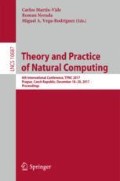Abstract
Dynamic Environments present many challenges for Evolutionary Computing. Frequency of change and amplitude of change, all have dramatic effects of how a system will behave. This in conjunction with poor search operators can lead to populations that can’t react to change quickly, as they have become converged in the search space. This study presents an overview of some methods to minimize the impact of change, and allow algorithms to better react to change in Dynamic Environments. Through the use of a bare bones tunable dynamic environment, it is shown how the approaches implemented can provide algorithms with faster responses to change. These approaches are also shown to do this without having to redesign the algorithms search operators, and maintaining the same computational effort.
Access this chapter
Tax calculation will be finalised at checkout
Purchases are for personal use only
References
Branke, J.: Evolutionary Optimization in Dynamic Environments. Kluwer Academic Publishers, Norwell (2001)
Dempsey, I., O’Neill, M., Brabazon, A.: Foundations in Grammatical Evolution for Dynamic Environments. Studies in Computational Intelligence. Springer, Berlin (2009). https://doi.org/10.1007/978-3-642-00314-1
Farina, M., Deb, K., Amato, P.: Dynamic multiobjective optimization problems: test cases, approximations, and applications. IEEE Trans. Evol. Comput. 8(5), 425–442 (2004)
Jong, K.A.D.: Evolving in a changing world. In: ISMIS, pp. 512–519 (1999)
Karcz-Duleba, I.: Dynamics of infinite populations evolving in a landscape of uni and bimodal fitness functions. IEEE Trans. Evol. Comput. 5(4), 398–409 (2001)
Karcz-Duleba, I.: Dynamics of two-element populations in the space of population states. IEEE Trans. Evol. Comput. 10(2), 199–209 (2006)
McDermott, J., Hemberg, E., Byrne, J.: PonyGE. https://github.com/jmmcd/ponyge.git. Accessed 12 Jan 2015
Morrison, R.W.: Designing Evolutionary Algorithms for Dynamic Environments. Springer, Verlag (2004). https://doi.org/10.1007/978-3-662-06560-0
O’Neill, M., Ryan, C.: Grammatical Evolution: Evolutionary Automatic Programming in a Arbitrary Language. Genetic programming. Kluwer Academic Publishers, Norwell (2003). http://www.wkap.nl/prod/b/1-4020-7444-1
O’Neill, M., Vanneschi, L., Gustafson, S., Banzhaf, W.: Open issues in genetic programming. Genet. Program. Evolvable Mach., 11, pp. 339–363 (2010). http://dx.doi.org/10.1007/s10710-010-9113-2
Rohlfshagen, P., Lehre, P.K., Yao, X.: Dynamic evolutionary optimisation: an analysis of frequency and magnitude of change. In: GECCO, pp. 1713–1720 (2009)
Sternberg, M., Reynolds, R.G.: Using cultural algorithms to support re-engineering of rule-based expert systems in dynamic performance environments: a case study in fraud detection. IEEE Trans. Evol. Comput. 1(4), 225–243 (1997)
Ursem, R.K., Krink, T., Jensen, M.T., Michalewicz, Z.: Analysis and modeling of control tasks in dynamic systems. IEEE Trans. Evol. Comput. 6(4), 378–389 (2002)
Yang, S.: Non-stationary problem optimization using the primal-dual genetic algorithms. In: Proceedings of the IEEE Congress on Evolutionary Computation, pp. 2246–2253. IEEE Press (2003)
Yang, S., Yao, X.: Population-based incremental learning with associative memory for dynamic environments. IEEE Trans. Evol. Comput. 12(5), 542–561 (2008)
Yen, G.G., Lu, H.: Dynamic multiobjective evolutionary algorithm: adaptive cell-based rank and density estimation. IEEE Trans. Evol. Comput. 7(3), 253–274 (2003)
Acknowledgements
This research is based upon works supported by the Science Foundation Ireland under Grant No. 13/IA/1850.
Author information
Authors and Affiliations
Corresponding author
Editor information
Editors and Affiliations
Rights and permissions
Copyright information
© 2017 Springer International Publishing AG
About this paper
Cite this paper
Fagan, D., O’Neill, M. (2017). Exploring Target Change Related Fitness Reduction in the Moving Point Dynamic Environment. In: Martín-Vide, C., Neruda, R., Vega-Rodríguez, M. (eds) Theory and Practice of Natural Computing. TPNC 2017. Lecture Notes in Computer Science(), vol 10687. Springer, Cham. https://doi.org/10.1007/978-3-319-71069-3_5
Download citation
DOI: https://doi.org/10.1007/978-3-319-71069-3_5
Published:
Publisher Name: Springer, Cham
Print ISBN: 978-3-319-71068-6
Online ISBN: 978-3-319-71069-3
eBook Packages: Computer ScienceComputer Science (R0)

